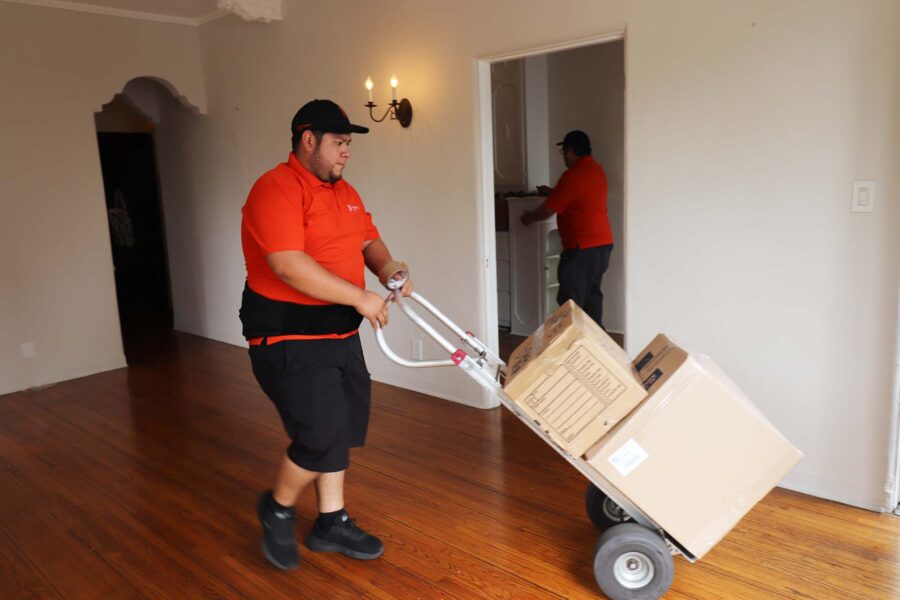

How Do You Move Heavy Furniture When Relocating Across the Country
Posted in How-to,Planning the Move on September 24, 2024
Whether it’s a large sectional, a solid wood dresser, or a king-sized bed, getting these bulky items safely to a new home requires some planning and strategy. So, how do you move heavy furniture when relocating across the country? With the right tips and tools, it doesn’t have to be as difficult as it seems.
How Do You Move Heavy Furniture?
Start by creating a detailed plan and using a cross-country moving checklist to organize your tasks. Gather essential tools like dollies, furniture sliders, and specialized blankets. Disassemble bulky items like bed frames and dining tables to make them easier to handle. Protect delicate surfaces with padding and plastic wrap.
Arrange heavy items first in the truck and secure them with tie-down straps. For a stress-free experience, consider hiring professionals such as Cross Country Movers who offer expertise and equipment for safely managing heavy furniture.
Create a Thorough Plan
When preparing for long-distance moving, having a solid plan is essential – especially when dealing with heavy furniture. A well-organized cross-country moving checklist and a detailed inventory list can make all the difference in keeping things on track and stress-free.
Start by creating a detailed inventory of all your large and bulky items. This will help you keep track of what’s being moved and which pieces require extra care. For instance, delicate items like antiques or glass tabletops need special protection, while oversized pieces might need to be disassembled before loading. Using organizational tools like checklists will ensure you don’t overlook anything important. Once your inventory is complete, map out a plan for disassembling larger pieces such as bed frames, dining tables, and sectionals.
Gather the Right Tools and Supplies
Transporting heavy furniture over long distances requires the right set of tools to ensure safety and efficiency. According to First Health Physical Therapy, if you hold more weight than your back can handle, you could hurt your spine. Injuries to the back that happened before lifting something heavy like equipment can also get worse. Having the proper equipment not only makes the process smoother but also protects valuable pieces from damage during transit.
Here are some essential tools that will help you avoid straining yourself physically:
- Dolly – Ideal for moving large items like dressers, couches, or even refrigerators with minimal effort.
- Furniture sliders – Help glide heavy pieces across floors without causing scratches or damage to surfaces.
- Moving blankets – These provide a thick layer of protection when wrapping furniture and prevent scratches, dents, or chips.
- Sturdy straps – Keep the items securely fastened during loading and transit, ensuring that nothing shifts or falls.
- High-quality padding: Adds extra cushioning around delicate items or edges to prevent any impact during the relocation.
These tools can be purchased or rented from hardware stores, rental companies, or specialty supply shops. Renting is often a cost-effective option for those handling a long-distance relocation, especially when heavy-duty equipment is only needed temporarily.

Disassemble Furniture When Possible
So, how do you move heavy furniture by yourself, and where do you even begin with the process? Disassembling bulky objects is a smart way to make large items easier to transport during a long-distance relocation. By breaking down pieces like bed frames, dining tables, and sectional sofas, you can reduce their size, making them easier to carry and load into the truck. This also minimizes the risk of damage and maximizes space.
Here’s a short guide to safely disassemble common furnishing.
Handle Bed Frames
For bed frames, start by removing the mattress and box spring. Once that’s done, unscrew the headboard and footboard from the bed rails. It’s important to keep all screws, bolts, and small parts organized – place them in a labeled bag, and tape the bag to one of the bed components to avoid losing any crucial pieces.
Tackle Dining Tables
With dining tables, the disassembly process typically begins by removing the legs, which are usually attached with bolts or screws. If the table has a removable leaf, take it out and wrap it separately. Be sure to protect the tabletop with padding or moving blankets to prevent scratches, and, as with the bed frame, keep all hardware in a labeled box or a bag for easy reassembly later.
Dismantle Sectional Sofas
For sectional sofas, start by separating the individual sections. Most sectional sofas are held together by clips or fasteners, which can be easily disconnected. Remove any detachable cushions or legs to make the pieces more manageable. Wrap each section in moving blankets to prevent damage, and label any hardware so that reassembling the sofa at the new location is straightforward.
Protect Each and Every Item Adequately
Ensuring that all your large belongings remain undamaged when moving across the country requires careful wrapping. Proper protection is key to preserving the condition of your items, particularly those with delicate surfaces.
Start by wrapping furniture with moving blankets or padding. These provide a thick layer of cushioning that can absorb impacts and prevent scratches or dents. For extra protection, use plastic wrap to secure the blankets in place and keep dust and moisture away. This wrap is especially useful for covering upholstery and other fabric surfaces, as it helps shield them from stains and tears.
Pay Special Attention to Delicate Surfaces
When dealing with delicate surfaces, such as glass or wood, extra caution is essential. For glass components, like tabletops or large mirrors, start by using bubble wrap or foam padding to cushion them. Then, place these wrapped items between sturdy pieces of cardboard for added protection. Secure the wrapping with tape to ensure it remains in place and provides a shield against potential impacts.
Wood has its own set of protective measures. Wrap these surfaces with padded materials to guard against scratches and dings. Cover them with protective covers or moving blankets to add an extra layer of defense.

Hire Professional Cross-Country Movers for Heavy Lifting
When it comes to moving heavy items, hiring professional long-distance movers can offer significant advantages, ensuring both safety and efficiency.
Professionals such as Cross Country Movers are equipped with the experience, tools, and techniques necessary to handle everything safely, reducing the risk of injury and damage to your belongings.
When you invest in cross-country moving services, one of the primary benefits is their expertise in lifting and maneuvering heavy items. They know the best practices for handling large furniture, from using specialized equipment like dollies and hoists to employing proper lifting techniques. This not only prevents personal injury but also safeguards each item from potential damage during the move.
They Offer a Wide Range of Services
Professional moving companies often offer a range of services that can help you move even smoother. These often include packing assistance, which ensures that items are securely wrapped and organized. Some companies also provide disassembly and reassembly, saving you the hassle of managing this yourself. Additionally, many offer storage solutions for those who need a temporary place for their belongings, as well as car shipping for vehicles.

Key Practices for Moving Heavy Furniture Safely
When it comes to handling heavy furniture, employing safe techniques is crucial to avoid injury and ensure the items remain in good condition. Here are some key practices to follow:
- Always lift with your legs, not the back. Bend your knees and keep the back straight while lifting. This helps the weight be spread out more evenly and takes the pressure off the back muscles. Keep the item close to your body to maintain balance and control.
- Never attempt to move heavy objects by yourself. Enlist the help of at least one other person to share the load. This not only makes the lifting process easier but also helps prevent accidents that can occur when handling bulky items alone.
- Moving straps are an excellent tool for distributing the weight of heavy items more evenly across your body. They also allow you to maintain a better grip and leverage, making it easier to maneuver bulky items through tight spaces or around obstacles.
- Before lifting, clear the path of any obstacles and plan the route to avoid potential hazards. This helps in moving furniture smoothly and reduces the chances of accidents or damage to walls and floors.
- If the relocation involves carrying heavy items over long distances or periods, take regular breaks to avoid fatigue. Overexertion can lead to mistakes and injuries, so ensure everyone involved stays refreshed and alert.
By following these safety techniques, you can reduce the risk of injury and make the process more manageable. Proper form, teamwork, and the use of tools like moving straps are essential for a successful and injury-free move.

Loading and Securing Furniture in the Truck
Loading heavy furniture into a truck requires careful arrangement to ensure stability and prevent damage during transport. Here’s how to do it effectively:
Arrange Heavy Items First
Begin by loading the heaviest items first. Place these items along the truck’s walls or floor to create a stable base. Positioning heavy items close to the truck’s floor and towards the front helps lower the center of gravity, reducing the risk of tipping.
Distribute Weight Evenly
Distribute the weight of the furniture evenly across the truck. Avoid concentrating all heavy items in one area, as this can lead to imbalance and make the truck harder to handle on the road. Arrange lighter items around the heavy pieces to fill gaps and create a stable load.
Use Tie-Down Straps
Secure heavy furniture with tie-down straps to prevent shifting during transit. Anchor the straps to the truck’s interior hooks or rails and tighten them firmly. This keeps the furniture in place and minimizes movement that could cause damage. Ensure that the straps are taut but not over-tightened, as excessive force can damage the item or the truck’s interior.
Protect and Pad Carefully
Cover furniture with specialized blankets or protective covers before loading them into the truck. This padding helps safeguard against scratches and dents. Place blankets or pads between items to prevent direct contact and potential damage.
Check and Adjust Everything
Once everything is loaded and secured, double-check that all items are stable and that the straps are properly fastened. Make adjustments as needed to ensure nothing is shifting or becoming loose during the drive.
Wrap It up and Book Professional Assistance for a Safe Move
Creating a solid relocation plan and employing proper protection techniques can make the whole process much smoother. For those who prefer to leave the heavy lifting to the experts, professional movers offer invaluable services.
If you’re preparing for a cross-country move and need assistance with heavy furniture, don’t hesitate to reach out to Cross Country Movers. Our team of professionals can handle all aspects of relocation, ensuring that the furniture and other belongings are transported safely and securely. Contact us today to get a quote and make the whole process of moving cross-country a breeze.





